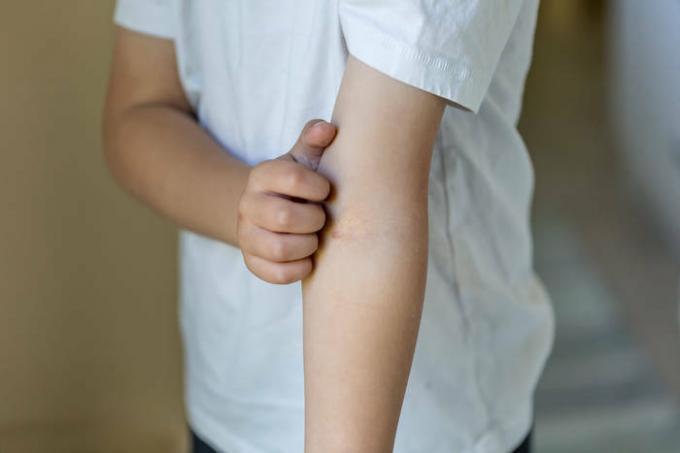The allergist told how to help an allergic child during spring flowering and what to do if he has anaphylactic shock.
It's real spring outside. Leaves bloom on trees, more and more flowers appear. For most people, this is a joy. But not for allergy sufferers. Indeed, during flowering, many of them begin hay fever - a seasonal allergic reaction to pollen. It settles on the mucous membranes of the nose, eyes, mouth, penetrates into the lower respiratory tract and causes swelling, inflammation, itching. A person endlessly wants to sneeze, a "flood" is pouring out of his nose, his eyes redden and itch. Rashes may appear on the body, urticaria, may worsen atopic dermatitis. In general, the condition is very, very unpleasant. How to help an allergic child in this difficult period for him, an expert told our site - Ekaterina Mikhailovna Kovbasko, pediatrician, allergist, head of the KinderKlinik department in Pechersk.

Itchy skin is a common manifestation of spring allergies.
More children with allergies
Recently, the frequency of allergic reactions has increased significantly.
“This can be explained by environmental pollution, the emergence of 'new' food additives in products, the early transition of many children from breastfeeding to formula,”- the expert explains.
The coronavirus pandemic also plays a role in this issue. For fear of infection, parents create sterile living conditions for the child, endlessly wash their hands and use antiseptics. As a result, the immune system, which has few external "enemies", malfunctions. This is how an autoimmune reaction appears - an allergy.
What plants are most often allergic to?
According to Ekaterina Kovbasko, the most frequent allergen in April and May is the pollen of beech trees (those that “bloom” with catkins). These include, for example:
- Birch;
- beech;
- hazel;
- alder;
- oak.

The main provocateur of pollinosis is birch catkins
In June and July, those who are allergic to cereal pollen suffer:
- timothy,
- foxtail,
- fescue,
- wheatgrass
- bluegrass.
In August and September, pollinosis can cause pollen:
- ambrosia,
- swans,
- wormwood.
“It is impossible to figure out what triggered the allergy on your own, without consulting an allergist. You can find out exactly what the reaction has arisen only by the results of the analyzes. Therefore, if symptoms of allergy appear, you should consult a doctor as soon as possible, ”- comments Ekaterina Kovbasko.
Do not delay the trip to a specialist, because hay fever, for example, can provoke the occurrence bronchial asthma.
What tests need to be passed for hay fever
In each case, the doctor determines the necessary tests. But, as a rule, the minimum "package" of studies for hay fever looks like this:
- provocative skin tests (scarification - the scratch method, prick tests - the injection method and intradermal tests with different sets of allergens);
- rhinocytogram - a study of the cellular composition of the nasal secretion;
- determination of general and specific IgE antibodies in blood serum.
Skin tests are one of the simplest diagnostic methods. But for their implementation there are a number of contraindications. It:
- the height of an allergic disease;
- taking antihistamines, hormonal drugs;
- age up to 3 years;
- acute infectious process.

Skin tests should not be done on children under 3 years of age.
How to help an allergic child with hay fever
First of all, you need to see a doctor. He will prescribe the necessary condition, depending on the symptoms. For example, with severe nasal congestion - vasoconstrictor nasal drops, with skin manifestations - gels to relieve itching of the skin.
"To alleviate the condition without consulting a doctor, it is possible to recommend only moisturizing the nose with a saline solution to moisturize and cleanse the nasal mucosa",- advises Ekaterina Kovbasko.
Do not delay your visit to the doctor also because he will give you a master class in case of anaphylactic shock.
“This is the most formidable, life-threatening allergy situation. In the case of anaphylactic shock, only andrenaline is used. This drug is now available in a special dosage form "epipen". Only an allergist can explain how to use this drug correctly ”,- emphasizes Ekaterina Kovbasko.
What should be the nutrition of a child with hay fever
If the child is not allergic to certain types of foods or other types of food intolerances, then, according to Ekaterina Kovbasko, it should not be limited in important food ingredients. Every dietary restriction must be seriously justified.
“It is often observed that babies are limited in dairy products or wheat products. This can lead to poor weight gain, physical retardation, "- the expert warns.
You will also be interested to read:
How does diaper allergy manifest?
What to do if your child is allergic to complementary foods

